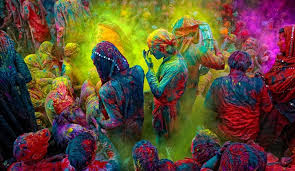Pitrapaksha (30th September 2012-15th October 2012)
Human body is made up of five Koshas – 1. Annamaya Kosha (body), 2. Pranmaya kosha (heart), 3. Manonaya Kosha (Mind) 4. Vigyanman Kosha (wisdom and knowledge),5. Anandmaya Kosha (blessings). These five koshas are intertwined into one another so as to help us transcend the cycle of life and death and attain liberation or merging with the Supreme.
After death, 4 koshas remain in this world. Other koshas keep moving and their movement is called Bhootgati. These Koshas leave the body one by one. In the end, when human body is burnt, soul departs from human body and all the koshas enter in Pretyoni. Manomaya kosha is very important in this yoni. So, it is human body which ends at the time of death and the soul which resides in the body, bears pleasure and pains because of desires in this yoni. When these desires end then this kosha is also liberated. All other three Koshas attain Devgati. Now, Anandnaya kosha remains alone and this gati is called Ishtgati. It denotes both manifestation and completion of the physical universe in total. In Ishgati, the being does not feel pleasure or pain and reaches Surya lok. From Surya lok it comes back to earth by the rays of the sun and enters the womb. In the tenth month it takes birth as human body in this world. Those who are liberated after death, their fire koshas are also liberated and they do not suffer in any one of these Gatis.
This is the natural cycle, which indicates that a being mainly faces two types of Gatis after death. One is Liberation and second is being trapped in a continuous cycle of life and death. In the first case, a being is liberated from all pains and desires. In the second case, being has to go or bear four Doshas and Yonis. Bhoot Yoni dies after the body is burnt, that is why a dying person hardly stays in that Yoni. At this time, there is no reason to perform any Shradhkarma or yagya. Of course, pind daan can be done. The duration of staying in Pretyoni depends upon the lust and desires of the dying person. The more it is involved in lust, the more it has to stay in Pretyoni and suffer. One cannot perform any Karma or religious work; neither can it experience physical pain or happiness because of its karma.
Happiness and sadness both are state of mind. Both virtuous and vicious get liberation from their subtle body after bearing the fruits of their karmas (good or bad) and when their desires are gratified. It is evident that by performing Shradhkarma in Shradhpaksha for the peace of ancestor’s souls in this birth, deceased ancestors get liberation from their bad deeds or sins. That is the reason, those who are physically present in this world, perform shradkarma for their dead ancestors during Pitra Paksha (fortnight of the ancestors is a period of 16 lunar days when Hindus pay homage to their ancestors especially through food offerings).
Some Pandits believe that Shradhkarma should be performed only in the honour of deceased ancestors, who are now residents of Pitralok (abode of ancestors) because when invocation is performed, these ancestors come and take whatever is offered to them. But if we think theoretically, we find that the ancestors who are unsatisfied souls who could not gratify their desires in their lifetime need respect and help from their successors to liberate them from the pain, as they are incapable to free themselves from the pains due to their non-existence in the world. Ancient literatures have described the instances of the
appearances
of the dead souls from Pitraloka during the time when Shradhkarma was performed. Some scriptures have described only the instances of some great men, accepting the homage performed by their successors. But these scriptures do not have references of receiving homage by ordinary souls. In fact, our ancestors have not been benefitted much by Shradhkarma, the way their successors or children are benefitted, because it is a ritual to repay debt to our deceased ancestors by gratifying their spirits and it is their religious responsibility also in order to make free their ancestors from their sins. That is the reason; Shradhakarma should be done with full devotion and in accordance with the principles described in Shastras.







